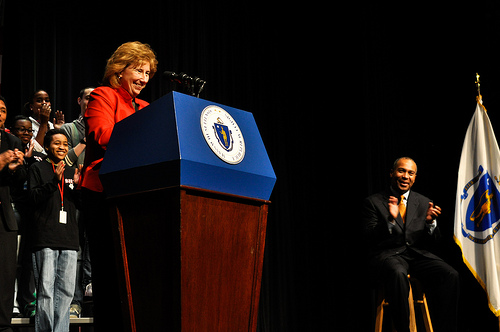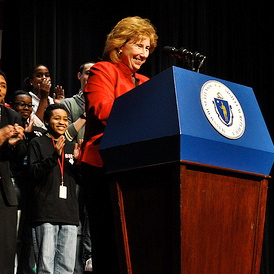
Susan Szachowicz
A few years ago, after giving a workshop at a Chicago-area conference, I relaxed over a deep-dish pizza dinner (what else?) with a few of the other presenters. I never forgot the no-nonsense approach of Susan Szachowicz, principal of Brockton High School. I was pleased to see her school profiled in today’s New York Times – “4,100 Students Prove ‘Small Is Better’ Rule Wrong” 9/27/2010.
While Arne Duncan, Oprah, and NBC’s “Education Nation” are busy blaming public school teachers, it was refreshing to see the NY Times highlight the turn around at Massachusetts’ Brockton High School that flies in the face of current ”educational reform du jour.”
A decade ago, Brockton High School was a case study in failure. Teachers and administrators often voiced the unofficial school motto in hallway chitchat: students have a right to fail if they want. And many of them did — only a quarter of the students passed statewide exams. One in three dropped out.
Then Susan Szachowicz and a handful of fellow teachers decided to take action. They persuaded administrators to let them organize a schoolwide campaign that involved reading and writing lessons into every class in all subjects, including gym.
Note that this reform was led by dedicated public school teachers (including Susan, who later became principal) advocating a return to basics – reading, writing, speaking, reasoning. It wasn’t a top-down mandate, restructuring or charter school take over. It was a (unionized) teacher-led initiative, supported by thoughtful administrators. It took place at one of the largest high school in the country – so much for Bill and Melinda’s “small is beautiful” approach.
Are public school teachers the problem or are they part of the solution? It depends on whether their unions put job security ahead of student performance. Teachers are responsible for results. But educational leaders, parents and the community are also responsible to support them. Accountability is reciprocal.
Kudos to the entire Brockton High School community. Their collaborative focus on instruction has resulted in dramatic improvements in student performance. It’s a lesson for parents, school leadership teams, teacher unions and education policy makers. Maybe Brockton can star in a sequel to “Waiting for Superman.”
Image credit: Flickr/Office of Governor Patrick


Reform from the bottom up, developed and pushed to entire school by teachers, one of the best ways to go.
What I don’t understand about Americans and their education is how much responsibility for the success or failure of the entire system is placed on the individual classroom teachers. Good grief, they teach with standards and standardized tests. As well, education is a federal matter. When I read about American education I get the idea that individual teachers are supposed to be “superheros” rather than professionals part of a well-functioning system. I remember reading in undergraduate sociology classes, that schools reflect the communities they serve. I think that refocussing on the role of the school as one part of an interrelated community would be more useful than bashing individual teachers.
Great model for change. The only part that “concerns” me, for lack of a better word, is the backward movement. “Back to the basics” seems to still be the battle cry of reformers. How about forward to some new set of essential skills and attitudes?
Thanks for this post. Your point is well-taken!
stephen
Great article in the NY Times. This is probably the best way to do it, where the teachers and administrators are leading the change for their school. Much of what they implemented – high expectations for students, teacher training, improving quality of instruction, uniting people behind a common purpose, getting all the teachers on board – is what teachers can do. Now, how do you get the teachers and administrators to do this? What was the motivator? Were the poor results on a high school exit exam what motivated them to change?
We can no longer accept schools that fail students year after year. There is no going back to the “bell curve.”
But on the other hand we can’t warehouse poverty into certain neighborhoods and put all the blame on teacher for the academic results we get.
It’s a complex problem that will require the “adults” (on all sides of the issue) to quit bickering and think about the needs of the children.
Stephen,
Thanks for the comment.
Having talked about the reform with Susan, I can tell you that “back to the basics” isn’t “code” for a return to outmoded techniques (such as drill and kill) – it’s closer to foundations of good instructional practice. Much like your call for essential skills.
Alex,
Thanks for your comments.
I can’t claim to speak for them, but I expect it was the growing realization that they could make a difference if they were willing to work together.
We adults have to stop making excuses (what do you expect from these kids… parent… etc) and focus on the factors that we can control (such as good instructional practice).